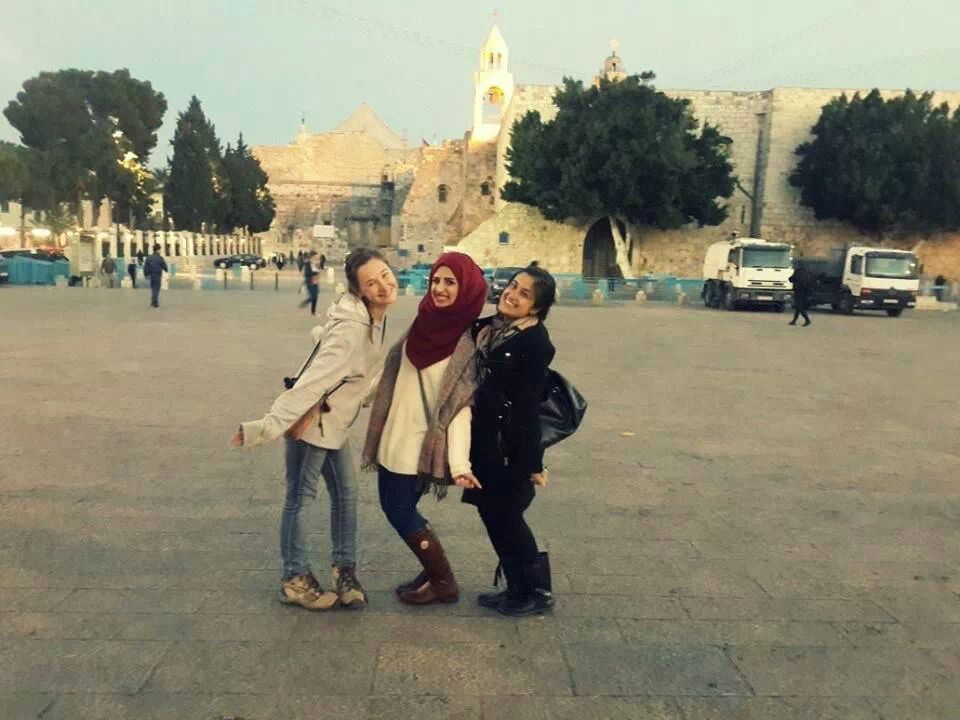the beautiful resistance of the women in palestine

Image: Jordan Kate Brown
In stark contrast to the stern Che Guevara, the symbol of Palestinian resistance is of a young woman knowingly smiling as she confidently grasps her semi-automatic. Leila Khaled was the world’s first female hijacker, and whether or not you believe that all is fair in love and war, her presence is artistically graffitied on the Separation Wall and throughout Aida refugee camp as a reminder to ‘not forget the struggle’.
But the Palestinian women of Bethlehem that I worked and lived with during my internship in the West Bank were unconcerned with the extreme measures that Khaled had passionately carried out in the late ’70s. Rather, they are pre-occupied with their families, education and careers. Women in Palestine have increasingly sought out tertiary education and now represent the majority of university students throughout the territory. Additionally, the Israeli occupation has led to a decline in the labour market, yet young women are more likely to be employed in Palestine than young men. Consequently, women are progressively becoming the breadwinners of households and, at times, are left to independently manage the day-to-day life of the family while men are increasingly forced to accept jobs on the other side of the world.
With local and international aid agencies and community development programs having a specific focus on women’s rights and women’s economic development, Palestinian women and men are fervidly discussing and acting upon issues of gender inequality. Community centres offer women vocational education and training, physical exercise classes, leadership workshops and legal counselling. However, women are also undertaking left-of-centre opportunities such as learning how to become yoga instructors in order to improve mental wellness, relieve stress disorders and instill a sense of inner peace within their communities. One woman excitedly told me about how she has led the first intensive yoga instructor course for men in the West Bank with 12 participants, two of which were Israeli. She raved that the results had been unbelievable and that she is eager to see the future outcomes once these men begin facilitating yoga lessons in their own communities.
That’s not to say that Palestinian women are disengaged from, or unaffected by, the ongoing conflict in the region. My dear housemate in Bethlehem explained to me that although women aren’t explicitly targeted by IDF soldiers, her daily commute to work is still an apprehensive event: sharing a taxi with friends or family means bearing witness to intimidation, threats and violence towards husbands, brothers and sons. As a clinical gynecologist, my housemate is responsible for prenatal care for many women in the region. Yet, patients are referred to hospitals that require travelling, often through checkpoints, when it is time to give birth.
Having witnessed Checkpoint 300, the main gateway between Bethlehem and Jerusalem, it reminds me of a cattle run where people are squashed and herded through metal detectors and controlled-access turnstiles while balaclaved men, armed and ready, stalk above on gangways. If that is the everyday experience of Palestinian people, then I do not find it hard to believe that 68 women since 2000 have been forced to give birth at checkpoints or by the roadside because soldiers have denied them entry. While the conflict between Israel and Gaza has abated since August, there are currently 46,000 pregnant women in the Gaza strip, of which 10,000 have been displaced. With only 3 out of 37 hospitals intact, a critical shortage of medical supplies and a continual blockade of the Gazan area, women are at significant risk of miscarrying or losing their own life during childbirth as an indirect result of the occupation.
Just as women are impacted by the Israel–Palestine conflict differently to the men in their life, their open defiance of their current circumstances is similarly personal and unique. While my grandpa jokingly asked me when I returned to Australia if the Palestinians had run out of stones to throw yet, the Palestinian resistance has adapted and evolved to manifest itself in myriad creative ways. Women, in particular, choose to fight the everyday human rights violations they are subjected to through education, theatrical performance, photography and embroidery.
Innovative methods to rebel to one’s current existence have been termed by the Al Rowwad Centre in Aida refugee camp as a ‘beautiful resistance’. Al Rowwad champions the concept of choosing to express emotions in a healthy, constructive manner rather than reflecting the hatred and violence that the Palestinians are surrounded by. As a result, photography and video cameras have become prominent weapons that have also ignited a new-found passion and audacity. Maryam, a young woman from Aida, is now cheekily taking photos of soldiers when they invade the refugee camp, while dreaming of becoming a documentary director. Although, with her brashness, it wouldn’t surprise me if she has done her fair share of stone throwing as well.
As there is in the West, there still remain social and cultural issues that negatively impact Palestinian women. But the young women who spoke adamantly to me about their role in society, squealed in delight over ‘The Voice Arabic’ and who I swapped boy stories with have challenged my views on feminism and what it means to refuse to accept the current circumstances enforced upon you. Without a doubt, there is an outrageously rebellious future for the Palestinian women. And like all social and political movements, you can either join them or be barrelled out of the way.


Proud of you Wijdan 🙂 , the article reflects the Palestinian reality good job Jorde 🙂